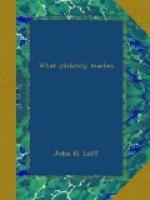[Illustration: Perforation]
The last form of perforation shown is called lozenge. In this the machine removes small diamond shaped pieces from the paper. The effect before the separation is shown between the pair of stamps, while the outer edges show the appearance of single copies.
[Illustration: Perforation]
A variety of machines are used in perforating stamps. One perforates only a single row of holes at a time. This is known as the guillotine machine because its action suggests that unpleasant instrument. Another machine is called the comb machine because the needles are arranged to perforate across the top of a row of stamps and at the same time between the stamps of that row. This arrangement somewhat resembles a comb. It will be seen that the first application perforates the stamps of one row on three sides. The application of the machine to the next row below completes the fourth side. In the best perforating machines the needles are arranged in circles around a spindle. The sheets pass under this roller and are perforated in one direction. A similar machine makes the perforations in the other direction.
There is another form of separation called rouletting, from the French “roulette”, a little wheel, its simplest form being produced by a small wheel with an edge of sharp points. By this process a series of small cuts is made between the stamps but none of the paper is removed.
[Illustration: Rouletting, Large Gauge]
[Illustration: Rouletting, Small Gauge]
In these two illustrations are shown roulettes of large and small gauge. The same result is also obtained by setting printers rules which have a notched edge between the cliches which compose the plate. These rules are set a trifle higher than the cliches so that, when the sheet of paper is pressed against the plate in printing, the points of the rules are forced through it. These points receive ink the same as other parts of the surface of the plate and the effect thus produced is called rouletting in colored lines.
[Illustration: Rouletting Forms]
[Illustration: Rouletting Forms]
There are a number of systems which produce the effect of rouletting in a variety of fancy forms. One is called perce en arc. This produces a series of arches on one stamp and a series of scallops on the adjacent one. Here is an example of this rouletting, in a small gauge. A similar form is called serpentine perforation. It is here shown.
[Illustration: Rouletting Forms]
[Illustration: Rouletting Forms]
Still another form leaves the edges of the stamps in sharp points. This is called perce en scie or saw-tooth perforation. When this perforation is very fine it is called serrate. There is still another form of rouletting, which we also show you. It is called rouletting in oblique parallel cuts and consists of a row of short cuts placed obliquely and parallel to each other. Stamps thus rouletted have a very ragged edge when torn apart. This roulette was only used in Tasmania and was a private production.




